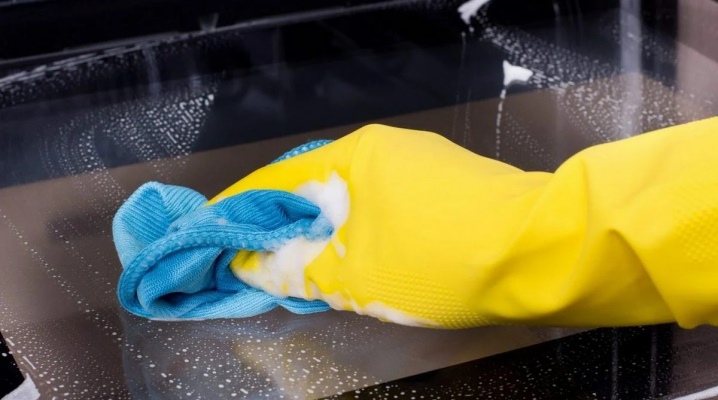How to choose household gloves?

Cleaning staff cannot do without household gloves. Housewives also need them. During cleaning and doing other household chores, contact with dirt and various chemicals is inevitable. Gloves help to protect the delicate skin of the hands from negative effects and prolong its youth. Today, the range of such products includes several varieties. Products differ in materials, design, purpose. Our article will tell you how to choose the right option.


Description
According to GOST, household gloves are a means of personal protection for hands during household work. This can be cleaning (daily or general), repairs, measures for the improvement of the personal plot, planting and caring for plants, etc.
Products repeat the shape of the hands, allow you to freely take some objects, hold the instrument. They protect skin from dirt, which is especially important in the presence of scratches (the material prevents the development of infection). Also, such protection is important for people with sensitive skin, because when in contact with detergents, some may experience allergic reactions. You should not ignore the use of such products and women who want to prevent dry skin of the hands and its premature aging.
It is important to remember that any household gloves are not designed to work with strong chemicals, industrial oils, solvents, gasoline and other hazardous substances. They also cannot protect from the impact of sharp objects.


Views
By material
- Natural rubber (latex). These are thin elastic products that preserve the sensitivity of the fingers. They resist pulling tears, but are easy to cut or puncture with a sharp object. The material quickly deteriorates upon contact with chemicals, so such models can quickly fail.
Latex products are suitable for working with water (washing dishes, fruits and vegetables, surface wet cleaning). They can also be used while working with paint.


- Made of artificial rubber (nitrile, vinyl). Nitrile and vinyl products are more durable and wear resistant. This is achieved by adding artificial fibers to the material. Such products better tolerate the effects of aggressive chemicals and mechanical stress. In this case, sensitivity is lost. In addition, such products are not very elastic. However, artificial models are better suited for mopping, cleaning plumbing. You can also use them in gardening work (when spraying with fertilizers, planting and moving crops around the site, weeding, harvesting, etc.).
To increase the ease of use, cotton spraying is applied to the inner surface of such products. This pile backing minimizes skin irritation and avoids direct contact with rubber.

- Silicone... A separate category includes silicone sponge gloves for washing dishes. On the inside of such products there is something like a brush made of the same material. Thanks to the silicone hedgehog, the user can completely abandon the use of the usual sponges. Elastic fibers create a large amount of foam from the detergent, perfectly cleaning dishes from grease and dirt.


- Textile. Knitted fabrics (cotton) with dotted PVC coating are intended for "dry" use. They are suitable for cleaning construction waste, carpentry, repair, storage and loading work, they are useful in contact with the ground in the garden, when caring for indoor plants. Such protective equipment is often used in manufacturing, construction, auto mechanics, and installation.
Models made of cotton fabric prevent the appearance of corns and scratches, protect from dirt and, to some extent, from mechanical damage (depending on the density and class of the product). They provide good adhesion to objects, allow the skin to "breathe", do not hinder movement due to their elasticity. Such gloves usually last a long time and fully justify their moderate cost.
The only drawback is that jerseys are not designed to come into contact with water and other liquids. In addition, in the absence of PVC spraying, the degree of protection of such models is noticeably reduced.

By appointment
All household gloves can be conditionally divided into several groups by purpose:
- plumbing - made of artificial rubber with a large cuff height, the most dense products;
- for cleaning premises - nitrile and vinyl models with cotton spraying;
- for washing dishes - products made of natural and artificial rubber, silicone;
- for cooking (washing fruits and vegetables, processing meat, fish, mushrooms) - models made of natural rubber;
- for "dry" works - fabric products;
- for the garden and vegetable garden - rubber and knitted models (the type of gloves is chosen depending on the type of work).




Which one is better to choose?
When choosing household gloves, there are several main aspects to consider.
- Appointment... Think about whether you will be in contact with water, dust or earth. The choice of material depends on this.
- The size... Gloves should sit comfortably on your hands, without dropping or applying pressure. You can find out the size by looking at the product packaging.
- Cuff length... Rubber products can be of different lengths. The higher this parameter, the higher the level of protection. However, do not forget that a long cuff can slightly restrict movement.
- Colour... The color gamut of rubber and silicone products is very wide. These are both black models and bright options (blue, green, yellow, pink). The choice depends on personal taste.
- Manufacturer... Many buyers prefer Japanese products. However, there are also worthy firms among Russian manufacturers.

For tips on choosing household gloves, see the following video.













The comment was sent successfully.